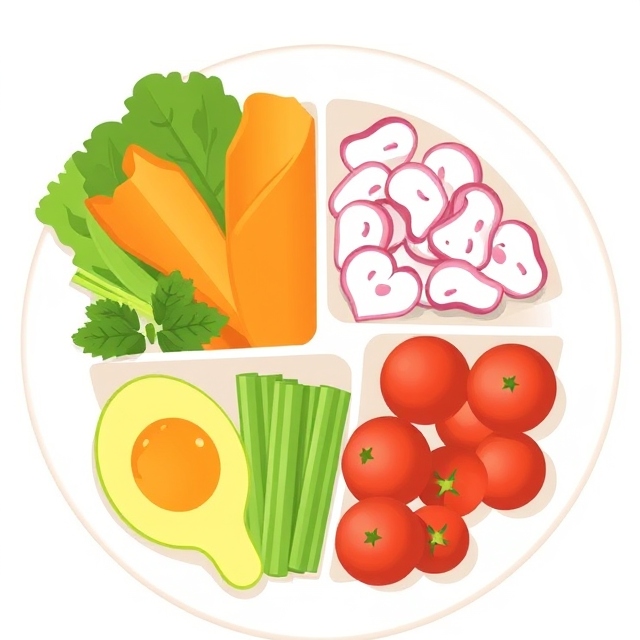How to Build a Balanced Plate When Life Feels Chaotic
Life doesn’t exactly slow down just because you decided to eat better.
You’ve got work.
You’ve got a kid who’s growing faster than your grocery budget.
You might even be helping out with your aging parents—or keeping your own energy afloat with a half-warm coffee in your hand.
So building a balanced plate? That can feel like a nice idea in theory.
But in practice? It feels like one more thing you’re not doing “right.”
Let’s change that.
Why “Balance” Gets So Confusing
You hear it all the time: “Just eat a balanced diet!”
But what does that actually mean?
Is it 30% carbs? Is it a rainbow? Is it all the food groups at once?
Truth is, most people don’t need complicated macros.
They just need a plate that’s not a chaotic mix of caffeine, regret, and toddler leftovers.
Let’s break it down.
The Formula: Simple Plate Building
Here’s a simple visual that works for almost everyone:
- ½ plate = non-starchy vegetables (think: broccoli, spinach, peppers, zucchini)
- ¼ plate = protein (chicken, eggs, tofu, beans, fish)
- ¼ plate = slow carbs or healthy fats (sweet potato, quinoa, avocado, olive oil, brown rice)
It’s flexible. It’s easy to eyeball.
And it doesn’t ask you to log every bite like you’re training for a nutrition exam.
But What If You’re Too Tired to Chop Vegetables?
Fair. Most of us aren’t chopping kale with jazz hands after a 10-hour day.
Try this:
- Buy frozen pre-cut veggies.
- Keep canned beans or tuna nearby.
- Use bagged salad + rotisserie chicken + microwaved brown rice.
- Eat on a paper plate if dishes are the real enemy.
Balanced doesn’t mean gourmet.
It just means fed in a way that supports your body.
Why Balanced Plates Help More Than Restrictive Diets
Restrictive diets are like bad exes.
They look good at first. They make promises.
But eventually, you’re just tired and hungry and wondering what went wrong.
Balanced plates don’t require perfection.
They adjust.
They teach your body to expect food consistently, which means less binging, fewer crashes, and more energy to handle life.
How to Build a Balanced Plate When You’re Out or Ordering In
Let’s keep it real—you’re not always cooking.
Here’s how to spot a balanced meal at a restaurant or drive-thru:
- Look for protein (grilled chicken, eggs, shrimp)
- Swap fries for fruit, salad, or steamed veggies
- Add a side salad even if it’s basic
No, it won’t be perfect. That’s okay.
You’re building better habits, not applying for the food police academy.
What If Your Family Eats Differently Than You?
Totally normal.
You’re not a short-order cook, but you also don’t want to eat boiled broccoli alone in the dark.
Try this:
- Build your base (protein + veggie + carb)
- Let them add extras (cheese, bread, sauce, dessert)
- Keep one part of the meal that everyone shares
It’s not about control.
It’s about setting up your plate with intention—even if the table’s a little chaotic.
Balanced Eating When You’re Emotionally Drained
We eat with our hearts too.
When stress is high, motivation is low.
Keep comfort foods that still nourish you:
- Lentil soup
- Egg and toast
- Tuna salad and crackers
- Oatmeal with peanut butter
These aren’t perfect, but they’re miles better than giving up and spiraling into a guilt-and-gummy-bear dinner.
You Don’t Need a Meal Plan. You Need a System.
Meal plans feel like a chore chart.
Systems feel like a rhythm.
Try this:
- Morning? Protein + carb (eggs + toast, smoothie + granola)
- Lunch? Protein + veggie (chicken + salad, tofu + stir fry)
- Dinner? One “fallback meal” you rotate weekly
- Snacks? Keep 2 healthy ones stocked always
Think of it like brushing your teeth.
You don’t need motivation. You just do it.
Progress Isn’t Measured in Macros. It’s Measured in Peace.
Did you feed yourself in a way that made you feel steady?
That’s a win.
Even if you ate pasta two nights in a row.
Even if dinner came from a takeout box.
Balanced eating helps your body and your mind.
It gives you one small piece of peace in a busy day.
Final Thoughts: One Plate at a Time
You don’t need to fix your whole routine.
Start with one plate.
Make it balanced.
Repeat tomorrow.
You’re not behind.
You’re learning how to take care of yourself again—in the middle of a messy life.
And that’s what real health looks like.




